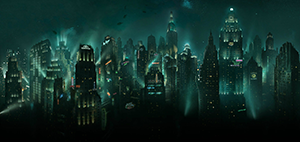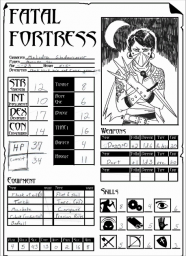If I were to draw a Venn diagram of the artistic inspirations of the new video game Prey, there’d be a big blue circle marked “Bioshock” and a big red circle marked “Dead Space 2” and where they overlapped, all that purple space would be marked Prey. Now, I’m not saying Prey is ripped off from Bioshock…
…wait, yes I am. I am exactly saying that Prey is a big old ripoff of Bioshock, right down to the psychic powers, wrench-as-a-weapon, and the late-game reveal that All Is Not What You Thought It Was. It’s just like Bioshock, but even more convoluted.
Prey has a twist beginning, then a series of misleading-yet-not-misleading clues that suggest something astonishing, then a double twist ending that both does and doesn’t negate all the previous clues. (And the final twist is only a surprise because there’s ABSOLUTELY NO FORESHADOWING WHATSOEVER. It’s an out-of-the-blue ending, without a bit of groundwork having been laid for it, which I believe professional writers refer to as “pulling it out of your ass”.) Arkane Studios, the developer, is baldly and nakedly aiming for a surprise on par with Bioshock’s shocking reveal, but none of it reaches the level of “Would you kindly?” (Then again, what has? Ever?)
BUT HOLD YOUR HORSES THERE, PARDNER! You might assume that because Prey gratuitously rips off two previous great games, it must therefore suck like the infinite vacuum of space. YOU WOULD BE WRONG. Prey is actually a pretty great game. It’s fun, tense, and varied, with puzzles, combat, and cool 3-D space maneuvering that only cheats the physics a little bit.
Plus, it has an old-school RPG in it.
You see, several of the denizens of the space station (look, as soon as I said Dead Space 2, you should have realized there was a space station) played a D&D-ish game called Fatal Fortress. The great thing is, the GM of the game handed her four players four different treasure maps, which if decoded and used in concert would lead the players to treasure. You, as the protagonist of Prey, then have to DECODE THE MAPS TO FIND THE TREASURE, and the quest to do so has you running your ass off all over the station, all the while monsters try to eat it.
That’s right, for one side mission they turned their survival-horror-in-space First Person Shooter into an old-school-style puzzle-and-monster dungeon crawl RPG.
In fact, the entire game might be considered a dungeon-crawl, and GM’s looking to find out what a dungeoncrawl feels like could do worse than to play this game. ESPECIALLY as it completely eschews the concept of “clearing out the dungeon”. Yes, you can kill all the monsters in an area, but sooner or later they WILL come back, often when you least expect. It keeps you on your toes.
Another thing that Prey does right, that GM’s can learn from, is ambiance. Bioshock is set in a fabulous city deep beneath the ocean waves (called Rapture, pictured above), and the designers of the game made sure that every room had some visceral reminder that the player was under the ocean. Windows peering out on the ocean depths, pools of water on the floor, or rivulets running down the wall from an unseen leak—the player was always reminded that this was no ordinary city.
Whereas Rapture felt like an undersea city, and the USG Ishimura from the original Dead Space felt like a blue-collar interstellar factory ship, the Talos 1 station from Prey feels like a space station custom-designed to make inhabitants forget they’re floating in the deep darkness of outer space. Many areas of the station come across like sections of an amusement park: there’s a wood-paneled and brass-fitted false front that gives people the illusion of luxury, but hidden behind this are crawl ways, exposed piping, and blank concrete. The contrast is stark.
The player gets to experience both the apparent luxury and the hidden utilitarian underpinnings of the station, and the dichotomy makes the station feel real, like you’re exploring an actual place. It’s verisimilitude gold. Gamemasters should shoot for the same goal in their own campaigns—use description to make the game world feel real by reminding players of unique aspects of the setting.
Good artists borrow; great artists steal. The only defense against accusations of ripping something off is to make something so good, the point is moot. Quality justifies its own existence, and in the end—despite some glitches and the occasional rough spot—Prey is a quality game.
Jasyn Jones, better known as Daddy Warpig, is a host on the Geek Gab podcast, a regular on the Superversive SF livestreams, and blogs at Daddy Warpig’s House of Geekery. Check him out on Twitter.
Have you played the System Shock games?
I recently played Darksiders and it’s incredibly derivative of numerous other games (God of War, Zelda, Portal, etc.) and its story is unintentionally hilarious, but it’s actually a pretty fun game. That’s the neat thing about video games – literally nothing matters as long as you’re having fun.
Games seem to be the only medium where ripping off is ok (mechanics wise) and “derivative” means nothing at all, either positive or negative. Gamers just call them “genres” and put them in different categories–shooters, action-adventure, “soulslike,” “metroidvania,” and so forth.
“Bioshock… IN SPAAAAAAAACE!”
So… System Shock 2? 😉
Also, good chunk of Arkane’s employees is made of ex-Looking Glass staff (ie original System Shock devs).
There are a lot of things mixed in.
I’d say it draws more from Deus Ex than from the Bioshock games.
Respawning monsters is cheap-ish.
It has been done a lot and it kinda makes things like “I want to save everyone I can” even more meticulous.
After you successfully knock off all thralls, you have to drag unconscious bodies somewhere safe if you don’t want anyone spawn on top of them.
The contrast between polished interiors and supporting machinery is good, but it’s hardly an unique feature.
It’s been used to a much greater effect in Portal, for instance.
What’s interesting is an attempt at the new “gravity gun”.
The GLOO cannon may or may not be imitated in later games, as the ability to climb anywhere is interesting, to put it mildly.
Overall the level design encourages attempts to circumvent it and that’s a hard thing to achieve.
Also an interesting thing is that you can farm level-ups by just 3d-printing the upgrade modules.
It’s technically available very early, though the selection of perks is limited till the mid-game.
I’m inclined to think it’s a good thing.
It’s a good game.
Not a great one, like System Shock 2, but a good one.
Unfortunately, in terms of narrative pacing it’s most similar to Aliens: Isolation.
As in you play and everything is fine and dandy, until at about 2/3 of the game you suddenly can’t care less and just watch the endings on Youtube.
Unfortunately, the game doesn’t have enough new things to support the latter third of the game.
Guns would have helped here, because you kinda get your full arsenal (except for the golden pistol) in the first third of the game.
As cliche as it sounds, throwing an assault rifle (standard-6) or a grenade launcher (heavy-1) and some different ammo should’ve been enough to get through it.
“Bioshock… IN SPAAAAAAAACE!”
So it’s basically System Shock?
Fatal Fortress is actually a reference to their earlier game, Arx Fatalis. Pretty sweet horror-fantasy action RPG, with a setting reminiscent of Hodgson’s Night Land.
“Unfortunately, in terms of narrative pacing it’s most similar to Aliens: Isolation.
As in you play and everything is fine and dandy, until at about 2/3 of the game you suddenly can’t care less and just watch the endings on Youtube.”
Whoa. Simply one of the best comments in a review context that I have ever read. Well said True_poser.

